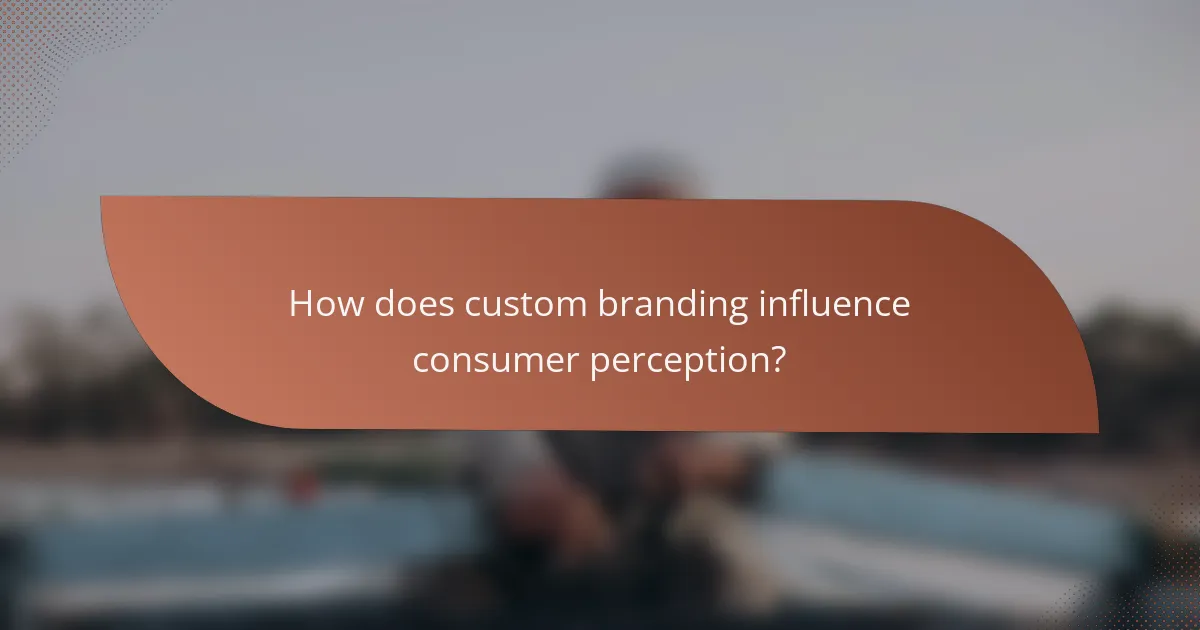Custom branding plays a crucial role in shaping consumer perception by establishing a unique identity that resonates with target audiences. By fostering recognition and emotional connections, effective branding enhances the perceived value of a brand and encourages deeper customer engagement. Key elements such as a distinctive visual identity and consistent messaging are essential for aligning with the values and preferences of the audience.

How does custom branding influence consumer perception?
Custom branding significantly shapes consumer perception by creating a distinct identity that resonates with target audiences. This tailored approach fosters recognition, emotional ties, and an overall sense of value associated with the brand.
Increased brand recognition
Custom branding enhances brand recognition by establishing unique visual elements such as logos, colors, and typography. These distinctive features help consumers easily identify and remember a brand amidst a crowded marketplace.
For example, brands like Coca-Cola and Apple have successfully utilized custom branding to create strong visual identities that consumers can instantly recognize. This recognition can lead to increased customer loyalty and repeat purchases.
Enhanced emotional connection
Custom branding cultivates an emotional connection between consumers and the brand by aligning its values and messaging with those of its audience. When consumers feel that a brand understands their needs and aspirations, they are more likely to engage with it.
For instance, brands that emphasize sustainability and social responsibility can attract consumers who prioritize these values. This emotional bond often translates into higher levels of trust and advocacy among customers.
Perceived quality improvement
Custom branding can lead to a perceived improvement in quality, as consumers often associate well-designed brands with superior products or services. A strong brand image can elevate consumer expectations and enhance their overall experience.
For example, luxury brands like Gucci or Rolex leverage custom branding to convey exclusivity and high quality, which justifies their premium pricing. This perception can significantly impact purchasing decisions and brand loyalty.

What are the key elements of effective custom branding?
Effective custom branding hinges on creating a distinct identity that resonates with your audience. Key elements include a unique visual identity, consistent messaging, and alignment with your target audience’s values and preferences.
Unique visual identity
A unique visual identity encompasses logos, color schemes, typography, and overall design aesthetics that distinguish a brand from its competitors. This identity should be memorable and reflect the brand’s core values, making it instantly recognizable to consumers.
For instance, a tech company might use sleek, modern designs and a blue color palette to convey innovation and trust. In contrast, a natural skincare brand may opt for earthy tones and organic shapes to emphasize sustainability.
Consistent messaging
Consistent messaging ensures that all communications reflect the brand’s voice and values across various platforms. This includes advertising, social media, customer service, and public relations efforts, which should all convey a unified message to strengthen brand recognition.
Brands should develop a style guide that outlines tone, language, and key messages. For example, a luxury brand may use sophisticated language and imagery, while a youth-oriented brand might adopt a more casual and playful tone.
Target audience alignment
Aligning branding efforts with the target audience is crucial for engagement and loyalty. Understanding the demographics, interests, and pain points of your audience helps tailor branding strategies that resonate deeply with them.
Conducting market research through surveys or focus groups can provide insights into what appeals to your audience. For example, a brand targeting millennials may prioritize social media engagement and sustainability, while one focused on older consumers might emphasize reliability and tradition.

How can custom branding enhance customer engagement?
Custom branding can significantly enhance customer engagement by creating a unique identity that resonates with target audiences. This tailored approach fosters emotional connections, encouraging customers to interact more frequently and meaningfully with the brand.
Personalized marketing strategies
Personalized marketing strategies leverage customer data to deliver tailored messages and offers. By understanding customer preferences and behaviors, brands can create targeted campaigns that speak directly to individual needs, increasing the likelihood of engagement. For instance, using email segmentation to send personalized product recommendations can boost open rates and conversions.
Consider implementing dynamic content in your marketing emails or website that adjusts based on user behavior. This can lead to higher engagement rates, as customers feel recognized and valued.
Community building through brand loyalty
Building a community around your brand fosters loyalty and encourages customers to engage with each other and the brand itself. This can be achieved through loyalty programs, social media groups, or events that bring customers together. For example, a brand that hosts exclusive events for loyal customers can create a sense of belonging and enhance engagement.
Encouraging user-generated content, such as reviews or social media posts featuring your products, can further strengthen this community. Brands that actively engage with their customers’ content can deepen connections and enhance loyalty.
Interactive brand experiences
Interactive brand experiences invite customers to engage actively rather than passively consuming content. This can include gamification elements, virtual reality experiences, or interactive social media campaigns. For instance, a brand might create an online quiz that helps customers discover products suited to their preferences, making the shopping experience more engaging.
Consider incorporating feedback loops, where customers can share their thoughts on products or experiences. This not only enhances engagement but also provides valuable insights for improving offerings. Brands that prioritize interaction often see higher customer satisfaction and retention rates.

What are the measurable benefits of custom branding for e-commerce?
Custom branding for e-commerce can significantly enhance a business’s perception, value, and customer engagement. By creating a unique brand identity, businesses can differentiate themselves in a crowded market, leading to tangible benefits such as increased sales and customer loyalty.
Increased conversion rates
Custom branding can lead to higher conversion rates by establishing trust and recognition among consumers. When customers identify with a brand’s unique identity, they are more likely to complete a purchase. A well-designed logo, consistent color scheme, and cohesive messaging can make a website more appealing, potentially boosting conversion rates by several percentage points.
To maximize conversion rates, ensure that branding elements are prominently displayed on product pages and throughout the checkout process. A/B testing different branding strategies can help identify what resonates best with your audience.
Higher customer retention
Effective custom branding fosters emotional connections with customers, which can enhance retention rates. When consumers feel a personal connection to a brand, they are more likely to return for repeat purchases. Brands that consistently deliver on their promises and maintain a strong identity can see retention rates improve significantly over time.
To improve customer retention, focus on creating a memorable brand experience through personalized communication and loyalty programs. Engaging customers through social media and email newsletters can also reinforce brand loyalty.
Improved average order value
Custom branding can positively influence the average order value (AOV) by encouraging customers to spend more per transaction. A strong brand identity can create a perception of quality, leading customers to feel justified in purchasing higher-priced items or additional products. Businesses often see AOV increase when they effectively communicate their brand values and benefits.
To enhance AOV, consider bundling products or offering exclusive deals that align with your brand’s image. Highlighting premium products or limited-time offers can also entice customers to increase their spending during a single visit.

What criteria should businesses consider when developing a custom brand?
Businesses should focus on understanding their target audience, market trends, and competitive landscape when developing a custom brand. These criteria help shape a brand’s identity, ensuring it resonates with consumers and stands out in the marketplace.
Market research insights
Conducting thorough market research is essential for businesses to identify customer preferences and behaviors. Surveys, focus groups, and social media analysis can provide valuable insights into what potential customers value in a brand.
Utilize tools like Google Trends or industry reports to gauge market demand and emerging trends. This information can guide branding decisions, ensuring alignment with consumer expectations and desires.
Competitor analysis
Analyzing competitors helps businesses understand their positioning within the market. Identify key players in your industry and evaluate their branding strategies, messaging, and customer engagement tactics.
Consider creating a competitive matrix to compare strengths and weaknesses. This can reveal gaps in the market that your brand can exploit, allowing for a more effective branding approach.
Brand differentiation strategies
To stand out, businesses must develop clear brand differentiation strategies. This can involve unique selling propositions (USPs), innovative product features, or exceptional customer service that sets the brand apart from competitors.
Consider leveraging storytelling to create an emotional connection with your audience. Highlighting your brand’s values and mission can foster loyalty and engagement, making it memorable in a crowded marketplace.

How does custom branding affect pricing strategies?
Custom branding significantly influences pricing strategies by allowing businesses to differentiate their products and justify premium pricing. A strong brand identity can create perceived value, enabling companies to charge higher prices than generic alternatives.
Perceived Value and Pricing
Perceived value is the customer’s assessment of a product’s worth based on branding. When a brand is associated with quality, trust, and prestige, customers are often willing to pay more. For example, luxury brands like Rolex or Louis Vuitton can command prices that far exceed those of non-branded items.
To leverage perceived value, businesses should focus on building a strong brand narrative and visual identity. This includes consistent messaging, high-quality materials, and exceptional customer service, all of which contribute to a higher perceived value and justify elevated pricing.
Market Positioning
Custom branding plays a crucial role in market positioning, which directly impacts pricing strategies. Brands that position themselves as premium or luxury can set higher prices, while those targeting budget-conscious consumers may need to adopt a more competitive pricing strategy.
Understanding your target audience is essential. Conduct market research to identify where your brand fits within the competitive landscape. This will help you determine the optimal pricing strategy that aligns with your brand’s positioning.
Pricing Models and Custom Branding
Different pricing models can be influenced by custom branding. For instance, value-based pricing focuses on the perceived value to the customer rather than the cost of production. This model works well for brands with strong identities that resonate with consumers.
Consider implementing tiered pricing strategies that reflect different levels of brand engagement. For example, a basic product line can attract budget-conscious customers, while premium offerings can cater to those seeking exclusivity and higher quality.
Common Pitfalls in Pricing Strategies
One common pitfall is underestimating the importance of brand perception in pricing. Businesses may set prices too low, undermining their brand value and positioning. This can lead to a perception of inferior quality.
Another mistake is failing to adapt pricing strategies as the brand evolves. Regularly assess market trends and customer feedback to ensure your pricing aligns with your brand’s current identity and value proposition.
